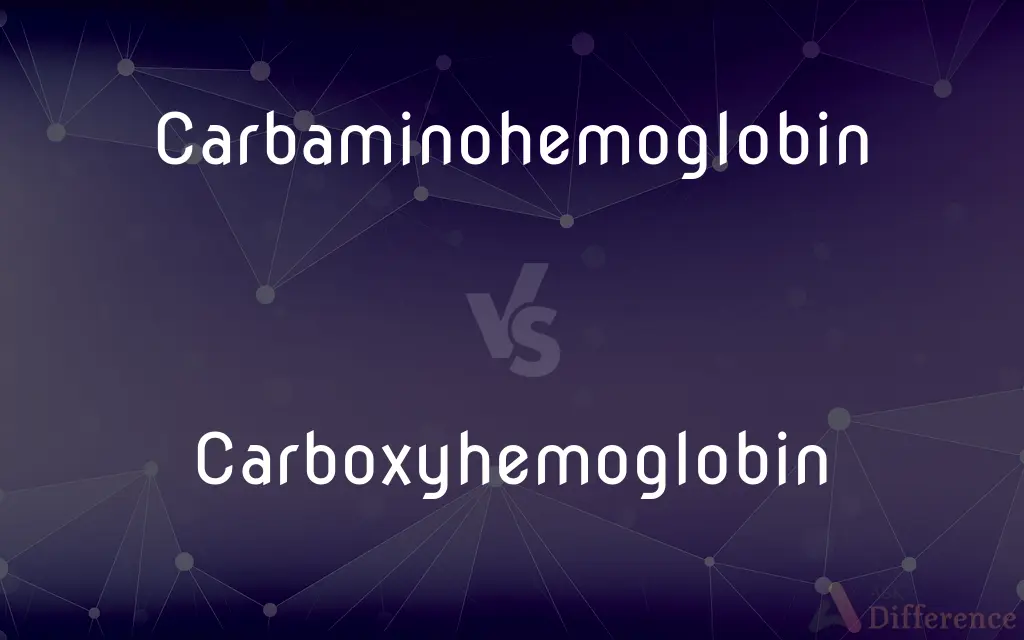Carbaminohemoglobin vs. Carboxyhemoglobin — What's the Difference?
By Tayyaba Rehman & Fiza Rafique — Updated on April 8, 2024
Carbaminohemoglobin is formed when CO2 binds with hemoglobin, aiding in CO2 transport; carboxyhemoglobin occurs when CO binds, reducing oxygen transport.

Difference Between Carbaminohemoglobin and Carboxyhemoglobin
Table of Contents
ADVERTISEMENT
Key Differences
Carbaminohemoglobin plays a crucial role in the transport of carbon dioxide from tissues to the lungs. It forms when carbon dioxide (CO2) binds to the amino groups of the hemoglobin molecule, which is different from oxygen transport. Whereas carboxyhemoglobin involves carbon monoxide (CO) binding with hemoglobin at the oxygen binding sites, interfering with the oxygen transport by reducing the amount of oxygen that can be carried. This difference highlights the functional and physiological impacts of these compounds on blood gas transport.
Carbaminohemoglobin formation is a normal and essential process in the body, facilitating the removal of carbon dioxide, a waste product of metabolism. On the other hand, the formation of carboxyhemoglobin is usually abnormal and harmful, occurring due to exposure to carbon monoxide, such as from smoking or inhaling exhaust fumes. This can lead to serious health consequences due to the reduced capacity of blood to transport oxygen.
The affinity of hemoglobin for carbon monoxide is much higher than for oxygen, making the formation of carboxyhemoglobin a competitive process that can significantly impair oxygen delivery to tissues. Meanwhile, the binding of CO2 to form carbaminohemoglobin does not directly compete with oxygen binding, allowing for the simultaneous transport of CO2 and oxygen.
The physiological implications of carbaminohemoglobin are generally beneficial, as it supports the efficient expulsion of carbon dioxide from the body. In contrast, carboxyhemoglobin formation can lead to hypoxia, tissue damage, and, in severe cases, death due to its ability to hinder oxygen delivery.
Detection and measurement of these compounds in blood can provide valuable information regarding a person's exposure to carbon monoxide or the efficiency of their CO2 transport mechanisms. Identifying elevated levels of carboxyhemoglobin is particularly important in diagnosing carbon monoxide poisoning.
ADVERTISEMENT
Comparison Chart
Definition
Hemoglobin bound to carbon dioxide (CO2) for transport from tissues to the lungs.
Hemoglobin bound to carbon monoxide (CO), which interferes with oxygen transport.
Function
Facilitates removal of CO2, a metabolic waste.
Reduces oxygen carrying capacity, leading to possible tissue hypoxia.
Formation Condition
Normal metabolic process during respiration.
Abnormal condition, often due to exposure to CO from smoke or exhaust.
Impact on Oxygen Transport
Does not directly compete with oxygen binding.
Competes with oxygen, reducing its transport capacity.
Health Implications
Essential for CO2 expulsion and overall respiratory function.
Potentially harmful, leading to carbon monoxide poisoning and tissue damage.
Compare with Definitions
Carbaminohemoglobin
Serves as a carrier for CO2.
Carbaminohemoglobin levels increase as blood collects CO2 from tissue cells.
Carboxyhemoglobin
Interferes with oxygen transport.
High levels of carboxyhemoglobin can lead to hypoxia and potential organ damage.
Carbaminohemoglobin
CO2 binding to the amino groups of hemoglobin.
The conversion of hemoglobin into carbaminohemoglobin is a reversible reaction facilitating CO2 transport.
Carboxyhemoglobin
A compound formed when carbon monoxide binds to hemoglobin.
Carboxyhemoglobin formation in the blood significantly reduces its oxygen-carrying capacity.
Carbaminohemoglobin
A complex formed when carbon dioxide combines with hemoglobin.
In the bloodstream, carbaminohemoglobin facilitates the transport of carbon dioxide from tissues to the lungs.
Carboxyhemoglobin
Indicator of CO exposure and potential poisoning.
Elevated carboxyhemoglobin levels are a clear marker of carbon monoxide poisoning.
Carbaminohemoglobin
Indicative of metabolic and respiratory activity.
Measuring carbaminohemoglobin can provide insights into respiratory function and metabolism.
Carboxyhemoglobin
CO binding at the oxygen sites of hemoglobin.
Carbon monoxide has a much higher affinity for hemoglobin than oxygen, leading to carboxyhemoglobin formation.
Carbaminohemoglobin
Essential for CO2 excretion.
Without carbaminohemoglobin, the removal of carbon dioxide from the body would be inefficient.
Carboxyhemoglobin
Critical for diagnosing and assessing the severity of CO poisoning.
Treatment plans for carbon monoxide poisoning often depend on the measured levels of carboxyhemoglobin.
Carbaminohemoglobin
Carbaminohemoglobin (or carbaminohaemoglobin, also known as carbhemoglobin and carbohemoglobin) is a compound of hemoglobin and carbon dioxide, and is one of the forms in which carbon dioxide exists in the blood. Twenty-three percent of carbon dioxide is carried in blood this way (70% is converted into bicarbonate by carbonic anhydrase and then carried in plasma, 7% carried as free CO2, dissolved in plasma).
Carboxyhemoglobin
Carboxyhemoglobin, or carboxyhaemoglobin, (symbol COHb or HbCO) is a stable complex of carbon monoxide and hemoglobin (Hb) that forms in red blood cells upon contact with carbon monoxide. Carboxyhemoglobin is often mistaken for the compound formed by the combination of carbon dioxide (carboxyl) and hemoglobin, which is actually carbaminohemoglobin.
Carbaminohemoglobin
A compound of haemoglobin and carbon dioxide, one of the forms in which carbon dioxide exists in the blood.
Carboxyhemoglobin
The compound that is formed when inhaled carbon monoxide combines with hemoglobin, binding more tightly than oxygen and rendering the hemoglobin incapable of transporting oxygen.
Carboxyhemoglobin
(protein) The stable complex of carbon monoxide with hemoglobin; it prevents the normal complexing with oxygen and thus leads to anoxia
Common Curiosities
What is carbaminohemoglobin?
It's a compound formed when CO2 binds with hemoglobin, aiding in its transport from tissues to the lungs.
Why is carbaminohemoglobin important?
It facilitates the removal of CO2, a waste product of cellular metabolism, from the body.
Can carbaminohemoglobin and carboxyhemoglobin levels be measured?
Yes, both can be measured in the blood to assess respiratory function and exposure to CO.
How does carboxyhemoglobin affect oxygen transport?
It binds to hemoglobin where oxygen normally would, reducing the blood's oxygen-carrying capacity.
How does the body handle carbaminohemoglobin?
It's transported to the lungs, where CO2 is released and exhaled.
What are the symptoms of carbon monoxide poisoning?
Symptoms include headache, dizziness, weakness, nausea, vomiting, chest pain, and confusion.
What causes the formation of carboxyhemoglobin?
Exposure to carbon monoxide, often from smoke or exhaust fumes, leads to its formation.
What are the health implications of high carboxyhemoglobin levels?
High levels can cause hypoxia, tissue damage, and even death if not treated promptly.
What is the difference in affinity between hemoglobin for CO2 and CO?
Hemoglobin has a much higher affinity for CO, making CO binding more competitive and dangerous.
How does carbon dioxide transport differ from oxygen transport in the blood?
CO2 is mainly transported as bicarbonate ions and carbaminohemoglobin, whereas oxygen is carried bound to hemoglobin.
Is carbaminohemoglobin formation reversible?
Yes, it's a reversible process that allows CO2 to be released in the lungs and exhaled.
How is carbon monoxide poisoning treated?
Treatment often involves moving the patient to fresh air and providing oxygen therapy, sometimes in a hyperbaric oxygen chamber.
Can smoking affect carbaminohemoglobin and carboxyhemoglobin levels?
Yes, smoking can increase carboxyhemoglobin levels due to CO inhalation and can also affect carbaminohemoglobin indirectly.
Share Your Discovery

Previous Comparison
Calamity vs. Disaster
Next Comparison
Convertible vs. RoadsterAuthor Spotlight
Written by
Tayyaba RehmanTayyaba Rehman is a distinguished writer, currently serving as a primary contributor to askdifference.com. As a researcher in semantics and etymology, Tayyaba's passion for the complexity of languages and their distinctions has found a perfect home on the platform. Tayyaba delves into the intricacies of language, distinguishing between commonly confused words and phrases, thereby providing clarity for readers worldwide.
Co-written by
Fiza RafiqueFiza Rafique is a skilled content writer at AskDifference.com, where she meticulously refines and enhances written pieces. Drawing from her vast editorial expertise, Fiza ensures clarity, accuracy, and precision in every article. Passionate about language, she continually seeks to elevate the quality of content for readers worldwide.














































